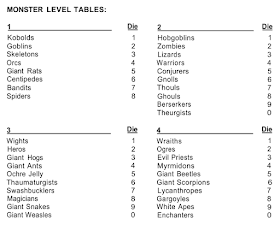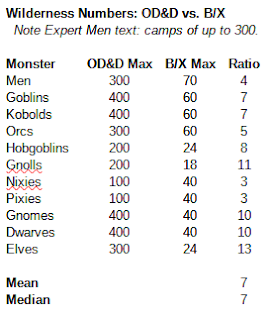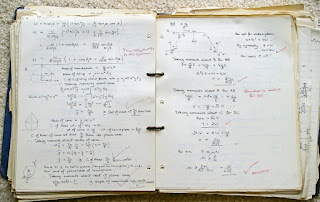There's a surprisingly small number of combat modifiers (adjustments to the combat rolls) in Original D&D. What did Gary and Dave think were important then? Using the 7th printing, let's take a look:
Volume 1: Men & Magic
- Fire missiles at +/−1 from Dexterity (p. 11)
- Missiles decrease AC by 1 at medium, 2 at short range (p. 20)
- Protection from evil spell gives "−1 from hit dice" (p. 23)
- Bless spell gives +1 to atack dice (p. 32)
That's actually it! Pretty minimalist, isn't it?
Volume 2: Monsters & Treasure
Monsters
- Berserkers get +2 for ferocity (p. 6)
- Dervishes get +1 like berserkers (p. 6)
- Mermen, as berserkers, but −1 on land (p. 7)
- Goblins, −1 in full daylight to attacks & morale (p. 7)
- Kobolds, as goblins (p. 7)
- Orcs, as goblins (p. 8)
- Dragons, hit at +2 if sleeping; elemental attacks get +/−1 (p. 12)
Treasures
- Magic swords, adds +1 to +3 probability of hitting (p. 30)
- Magic armor, subtracts 1 to 3 from hit dice of opponents (p. 31)
- Magic miscellaneous weapons, as swords, +1 to +3 (p. 31)
- Potion of invulnerability, +2 to defensive capabilities (p. 32)
- Ring of protection, as +1 armor (p. 33)
- Staff of striking, +1 to hit (p. 35)
- Staff of wizardry, +1 to hit (p. 35)
- Displacer cloak, +2 to defense (p. 36)
Vol-3: The Underworld & Wilderness Adventures
I actually couldn't find any combat modifiers in this volume.
Chainmail
Now, there's quite a bit of evidence that we are meant in include rules from Chainmail by reference, so as an added bonus here's a listing from the Man-to-Man Combat and Fantasy Supplement sections of that work. In fact, this may dig up most of the situational combat modifiers we would have expected from Vol-3. Looking at the 7th printing:
Man-to-Man Combat
- Mounted vs. non-mounted: mounted get +1, non-mounted −1; or in first round horsemen add +2 (p. 25, repeated on p. 26)
- Attacks against rear: add +1 to the die roll (p. 25)
- Parry: subtract −2 from attacker's roll if allowed by weapon type (p. 25-26)
- Leaders: +1 on all dice (p. 26)
- Viking berserkers: +2 on attack dice (p. 26)
Note that inspecting the missile fire tables (p. 41), in the majority of cases, there is a +2 benefit to being at short range, and +1 for medium range.
Fantasy Supplement
- Goblins/Kobolds: in full daylight or bright light subtract −1 from morale and any die rolled (p. 29)
- Orcs: react to light as goblins (p. 30)
- Heroes: add +1 to dice of their unit; +1 on dice for magic arrow vs. dragons; Rangers are heroes with +1 on attack dice (p. 30)
- Elementals: add one or two to dice roll against favored opponents (p. 36)
- Wights/Ghouls/Zombies: subtract −1 from die rolls in full light (p. 37)
- Magical swords: +1 to dice score vs. fantastic creatures; super-swords like Excalibur may give +2 or +3 (p. 38)
- Magic armor: subtracts −1 from opponent attacks on Fantasy Table, or −3 on Man-to-Man attacks (p. 38)
Conclusions
It's been said before, but one of the reasons I wanted these numbers collected in one place is this: While I didn't say it above, it's not entirely fair to compare all these numbers in parallel, because there's at least 3 different mechanical systems that might apply here.
- For "normal" combat in the Chainmail Fantasy Supplement, 1d6 would be rolled per figure (using the same resolution tables as the mass combat base game).
- For both "fantastic" and Man-to-Man Combat, 2d6 rolls are made as the mechanic.
- For Original D&D "alternative" combat, the 1d20 is used.
There's quite a bit of room for different interpretations about which system should be applied when. E.g.: The Chainmail Fantasy Supplement refers both to the regular mass combat tables, and also the Man-to-Man system (see under Magic Armor). The Original D&D text by default claims to use the Chainmail Fantasy system (but which one, when?), but has an "Alernative Combat" option using the d20 (and yet original players claim only the d20 system was ever used in practice).
On the d6 the range is 6; for 2d6 the range is 11; and on the d20 the range is (obviously) 20. That is: the range of possible rolls roughly doubles in each step of these three systems. So if we were converting modifiers, we could reasonably expect to scale any one by about double for any level of transition. But this seems to have been overlooked, and modifiers are copied between systems unchanged. For example:
- Berserker ferocity is +2 in both Chainmail and OD&D.
- Goblinoid light penalty is −1 in both Chainmail and OD&D.
- Magic swords and armor apply a +1 to +3 modifier in any book.
- Missile-fire range adjustment of +1 or +2 is identical in each book.
Similarly, the situational modifiers we see in Chainmail Man-to-Man Combat (while not copied into OD&D) reappear basically unchanged in the 1E AD&D DMG. Note for one example the shift in the effect of goblinoid −1 penalty in daylight is enormously different from one extreme of systems to the other: in the OD&D d20 system, it's a fairly minimal 5% adjustment, whereas back in Chainmail Fantasy "normal" combat, it makes them utterly unable to hit anything except Light Foot (granted that all other targets are hit only on a "6" on d6).
Arguably, the most coherent interpretation might be that the OD&D text really was written assuming that Chainmail combat mechanics (well: some mix of the 3 there) were in effect, and the rise of the d20-based "Alternative" failed to take into account the need to adjust those modifiers. But no such errata ever appeared in either the supplements or even AD&D, so we got stuck with fairly fiddly small modifiers that at one point were huge game-changers.
Secondarily, there's also the interesting feature that some but not all monster modifiers got copied from Chainmail into OD&D. Things that were copied: bereserker ferocity and goblinoid light penalties. Things that were not copied: undead attack penalties in light (and also some things like special dragon senses, which reappeared in AD&D but not the B/X line).
Should we be adjusting modifiers that originally appeared in Chainmail (such as goblinoid light penalties) by as much as quadrupling them to scale to the d20 attack system? Anything that I missed in my survey?
This post is a result of a poll of what Wandering DMs patrons most wanted to see here for the month of November. If you'd like to get in on next one join us at Patreon!


























